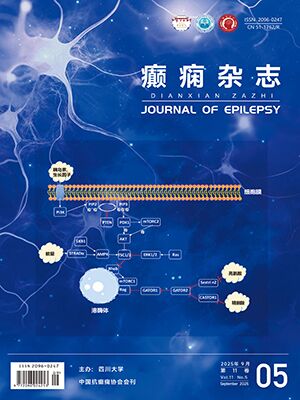| 1. |
Malumbres M, Barbacid M. RAS oncogenes: the first 30 years. Nat Rev Cancer, 2003, 3(1): 459-465.
|
| 2. |
Stromme P, Mangelsdorf ME, Scheffer IE, et al. Infantile spasms, dystonia, and other X-linked phenotypes caused by mutations in aristaless related homeobox gene, ARX. Brain Dev, 2002, 24(5): 266-268.
|
| 3. |
Olivetti PR, Maheshwari A, Noebels JL. Neonatal estradiol stimulation prevents epilepsy in Arx model of X-linked infantile spasms syndrome. Sci Transl Med, 2014, 6(220): 220-212.
|
| 4. |
Grosso S, Brogna A, Bazzotti S, et al. Seizures and electroencephalographic findings in CDKL5 mutations: case report and review. Brain Dev, 2007, 29(4): 239-242.
|
| 5. |
Bahi-Buisson N, Kaminska A, Boddaert N, et al. The three stages of epilepsy in patients with CDKL5 mutations. Epilepsia, 2008, 49(6): 1027-1037.
|
| 6. |
王紀文, 葛麗娟, 孫若鵬.鈉離子通道A1亞單位基因突變與癲癇關系的研究進展.中華兒科雜志, 2008, 46 (10): 797-800.
|
| 7. |
Heilstedt HA, Burgess DL, Anderson AE, et al. Loss of the potassium channel beta-subunit gene, KCNAB2, is associated with epilepsy in patients with 1p36 deletion syndrome. Epilepsia, 2001, 42(9): 1103-1111.
|
| 8. |
Liu ZL, He B, Fang F, et al. Analysis of single nucleotide polymorphisms in the melanocortin-4 receptor promoter in infantile spasms. Neuropediatrics, 2007, 38(6): 304-309.
|
| 9. |
Eli Ragona F, Brazzo D, Degiorgi I, et al. Dravet syndrome: early clinical manifestations and cognitive outcome in 37 Italian patients.Brain Dev, 2010, 32(1): 71-77.
|
| 10. |
Morse RP. Dravet syndrome: inroads into understanding epileptic encephalopathies. J Pediatr, 2011, 158(3): 354-359.
|
| 11. |
Khan S, Al Baradie R. Prevalence of SCN1A mutations in children with suspected Dravet syndrome and intractable childhood epilepsy. Epilepsy Res, 2012, 102(3): 403-592.
|
| 12. |
Tonekaboni SH, Ebrahimi A, Bakhshandeh Bali MK, et al. Sodium channel gene mutations in children with GEFS+ and Dravet syndrome: across sectional study. Iran J Child Neurol, 2013, 7(2):31-36.
|
| 13. |
Soneijen Schouwenaars FM, Veendrick MJ, van Mierlo P, et al.Carbamazepine and oxcarbazedine in adult patients with Dravet syndrome: friend or foe.Seizure, 2015, 29(3): 114-118.
|
| 14. |
Chu-Shore CJ, Major P, Camposano S, et al. The natural history of epilepsy in tuberous sclerosis complex. Epilepsia, 2010, 51(7):1236-1241.
|
| 15. |
Au KS, Williams AT, Roach ES, et al. Genotype/phenotype correlation in 325 individuals referred for a diagnosis of tuberous sclerosis complex in the united states. Genet Med, 2007, 9(2): 88-100.
|
| 16. |
Sancak O, Nellist M, Goedbloed M, et al.Mutational anaIysis of the TSC1 and TSC2 genes in a diagnostic setting: genotype-phenotype correlations and comparison of diagnostic DNA techniques in tuberous sclerosis complex.Eur J Ham genet, 2005, 13(6):731-741.
|
| 17. |
Hong SE, Shugart YY, Huang DT, et al. Autosomal recessive lissencephaly with cerebellar hypoplasia is associated with human RELN mutations.Nature Genetics, 2000, 26(1): 93-96.
|
| 18. |
Najm J, Horn D, Wimplinger I, et al. Mutations of CASK cause an X-linked brain malformation phenotype with microcephaly and hypoplasia of the brainstem and cerebellum. Nat Genet, 2008. 40(4): 1065-1067.
|
| 19. |
薛寧, 王紀文.嬰兒痙攣的分子遺傳學研究進展.實用兒科臨床雜志, 2010, 25 (4): 299-301.
|




